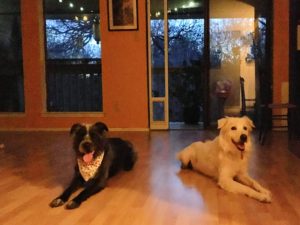Adding a new dog to your home is a very exciting time. Some of the first things you’ll want to do with your new addition will be to take them to the pet store and pick out a brand new collar, squishy bed, and the perfect type of treats. Then you’ll want to take them to Zilker Park, the patio at Trudy’s, and, of course, Red Bud Isle. That’s a lot of stimulation for a dog who has been taken from a home they possibly grew up in, maybe bounced around shelters, and interacted with a bunch of strangers over a short period of time. Trainers and long-time foster families are actually now recommending a “Two Week Shutdown” for new adoptions. This provides an opportunity for a dog to adjust slowly to its new environment. There will be new smells, new food, new people, a new routine, and this is all very overwhelming for doggy minds. By implementing the shutdown, the dog will learn to trust you and your other family members, learn that this is its new home, and it will set them up for success in the future.

Inside the home, you’ll want to set up a safe space for your new dog, so they will be able to retreat if they are uncomfortable or overwhelmed. Some dogs will prefer a crate, but you can also use a pen, or a small quiet room. Trainers recommend keeping the dog in their safe space for as much of the day as possible for those first two weeks. They should also never be left with full access to the house if you have to leave them alone. You should keep a leash on the dog around the house as well, in case you need to guide them off furniture or coax them outside. Remember that you don’t know anything about the way this dog reacts to being taught new rules in a new home, so a leash will help you keep a safe distance and allow you to get control of the dog if needed. Also remember that you don’t know how this dog will react to being touched by new people, so for the first few weeks, only pet the dog if it comes up and solicits it from you first. Never, ever put your face close to a dog’s face until it has had enough time to bond with you and knows it can trust you. Training should be limited to just establishing rules in your new home, nothing beyond the basics. Don’t worry, there will be plenty of time to teach them to open the refrigerator and bring you a beer after these two weeks are over.
If possible, try to keep them separated from other dogs during the shutdown period as well. If there is already a resident dog, you can crate them next to each other so they have time to learn each other’s smell. Once you start to let them interact, make sure you are always around to supervise. Trainers recommend not leaving your new dog alone with your existing pet(s) for at least three months.
This may seem like a lot of restrictions, and it can be frustrating when all you want to do is show off your amazing and adorable new dog. It really is essential for a dog to be allowed enough time to adapt and explore its new family and home, and at a slow pace. Two weeks is just a guide, some dogs may even need longer. It will all be worthwhile when you see your dog’s personality blossom and they successfully integrate into your household.



